Boxer (armoured fighting vehicle)
The Boxer is a multirole armoured fighting vehicle designed by an international consortium to accomplish a number of operations through the use of installable mission modules. The nations participating in the Boxer program have changed as the program has developed. The Boxer vehicle is produced by the ARTEC GmbH (armoured vehicle technology) industrial group, and the programme is being managed by OCCAR (Organisation for Joint Armament Cooperation). ARTEC GmbH is based in Munich; its parent companies are Krauss-Maffei Wegmann GmbH and Rheinmetall Military Vehicles GmbH on the German side,[4] and Rheinmetall Defence Nederland B.V. for the Netherlands.[5] Overall, Rheinmetall has a 64% stake in the joint venture.
| Boxer | |
|---|---|
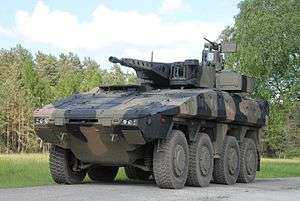 Boxer configured for Australia's Land 400 Phase 2 for which the type was selected in March 2018 | |
| Type | Armoured fighting vehicle |
| Place of origin | Germany/United Kingdom/Netherlands (further details in main text) |
| Service history | |
| In service | 2011–present |
| Used by | See Operators |
| Production history | |
| Designer | ARTEC GmbH |
| Designed | 1998–2009 |
| Produced | 2009–present |
| No. built | 539 as of February 2020[1] Production continues. |
| Specifications | |
| Mass | 24,000 kg (standard); 36,500 – 38,500 kg (combat)[2] |
| Length | 7.93 m (26 ft 0 in) |
| Width | 2.99 m (9 ft 10 in) |
| Height | 2.37 m (7 ft 9 in) (baseline vehicle) |
| Crew | Varies by role. In APC configuration – 3 + maximum of 8[2] |
| Armor | AMAP composite armour |
Main armament | various, depends on configuration |
| Engine | MTU 8V199 TE20 Diesel rated at EURO 3[3] 530 kW (711 hp) in A0/A1/A2 and 600 kW (805 hp) in A3 (see text for full details) |
| Power/weight | 16.1 kW/t (max weight @ 530 kW)) |
Operational range | 1,100 km (684 mi) |
| Maximum speed | 103 km/h (64 mph) |
A distinctive and unique feature of the vehicle is its composition of a drive platform module and interchangeable mission modules which allow several configurations to meet different operational requirements.
Other names in use or previously used for Boxer are GTK (gepanzertes Transport-Kraftfahrzeug; armoured transport vehicle) Boxer and MRAV (multirole armoured vehicle).[6] Confirmed Boxer customers as of February 2020 are Germany, the Netherlands, Lithuania, Australia and the UK. The Boxer has been produced in A0, A1 and A2 configurations. The UK will receive the A3 Boxer, and Australia is receiving an A2/A3 hybrid.
Production history
With exceptions for style and ease of reading, the following development and production history is presented in as near-chronological order as possible.
The Boxer is a cooperative European design project, the initial aim of which was to develop the next generation of armoured utility vehicle. The project was originally started as a joint venture between Germany, United Kingdom and France. France left the programme in 1999 and pursued its own design, the Véhicule Blindé de Combat d'Infanterie (VBCI).
Following negotiations, a contract was awarded in November 1999 for eight prototype vehicles, four for Germany and four for the UK. Total value of this contract was £70 million. In February 2001, the Netherlands joined the programme and 12 prototypes were built, four for each of the three countries.[2] On 12 December 2002 the GTK/MRAV/PWV was unveiled in Munich, Germany. The second prototype (PT2) was rolled out and the vehicle was named Boxer. At this time the first production run was to have been for 600 vehicles, 200 for each country.
In July 2003, shortly after the start of the Iraq War, the UK Ministry of Defence announced its intention to withdraw from the Boxer programme and focus on the Future Rapid Effect System (FRES).[2] In October 2003, the first Dutch prototype was delivered.
The Netherlands confirmed in the autumn of 2006 the procurement of 200 Boxers, these to replace the M577 and the support variants of the YPR-765 in the Royal Netherlands Army. Deliveries were scheduled to run from 2013 through to 2018, with vehicles coming from the Netherlands production line. Within the RNLA the baseline Boxer is called the Pantserwielvoertuig (PWV). Also in 2006, on 13 December the German parliament approved the procurement of 272 Boxers for the German Army,[7] to replace some of its M113 and Fuchs TPz 1 vehicles.[8][9]
Production deliveries of Boxer had been scheduled to commence in 2004, but numerous design changes combined with political problems delayed production until 2008, and the first production example was handed over to the German Army on 24 September 2009. Prior to deliveries commencing, the 12 prototypes were put through a series of reliability trials (over 90,000 km) and durability trials (over 90,000 km) over a seven-year period.[2] There are three production facilities for Boxer, one in the Netherlands (Rheinmetall) and two in Germany (Krauss-Maffei Wegmann and Rheinmetall).[2]
2010s
In December 2015 it was announced that Germany had placed a contract for an additional 131 Boxers worth EUR476 million.
In December 2015 it was announced that Lithuania had selected the Boxer. In August 2016 a EUR385.6 million production contract was placed with OCCAR for the supply of 88 Boxers, this understood to have been 84 IFV and 4 command vehicle variants. At this time it was stated that 53 Boxer would be manufactured by KMW and the remaining 35 by Rheinmetall, with deliveries running from 2017 through to 2021. In Lithuanian service the vehicle is designated as Vilkas (Wolf). The precise mix/number of Lithuanian vehicles has not always been clear, much of this down to wording/description of variants. Lithuania will receive a total of 91 Boxer in A2 configuration, 89 as variants of the baseline IFV configuration, plus two driver training vehicles. The exact IFV breakdown is: 55 IFV squad leader, 18 IFV platoon leader; 12 IFV company leader; 4 IFV command post. A single IFV will be used for maintenance training. The first two vehicles (driver training configuration) were delivered to Lithuania in December 2017.[10] The first two Boxer in IFV configuration were delivered on 25 June 2019 and at this time the Lithuanian MoD stated that 15 vehicles would be delivered to Lithuania in 2019, and that all 89 IFV variants would be delivered by the end of 2021.[11][12]
In June 2017 it was announced that the Bundeswehr's Boxer A1 fleet would be upgraded to A2 standard. Of the original German Army order most were delivered in A1 configuration, however 40 APC and 16 command post had been delivered in A0 configuration. These were subsequently upgraded to A1 configuration. The first A2 configured Boxer was delivered in June 2015.[2] According to ARTEC, the differences between A1 and A2 configuration are relatively minor electrical and mechanical engineering changes.[9]The A2 standard resulted from operations in Afghanistan and incorporates changes in the drive and in the mission module that include preparation for the integration of a driver vision system, changes to the stowage concept in both modules, changes to the gearbox, integration of a fire suppression system, modification of the RCWS, interface for an IED jammer, satellite communication system and other minor modifications."[13] The latest variant is the A3, the British the first customer for A3 in its entirety.[9]
On 4 July 2017 ARTEC awarded the then Rheinmetall MAN Military Vehicles (RMMV) a contract to upgrade 38 Bundeswehr Boxer command vehicles to A2 configuration. The value of the contract was stated to be €21 million. Work is scheduled for completion in mid 2020. At this time the Bundeswehr also had 124 Boxer APCs, 72 ambulances and twelve driver training vehicles to upgrade to A2 status.[14]
In February 2018 it was announced that Slovenia had selected the Boxer as the basis for two new mechanised infantry battle groups. Confirmation of a final proposal schedule for the procurement, which will be via OCCAR, was originally scheduled for September 2018. In November it was revealed that pricing issues had impacted the Slovenian timeline and that a new proposal from industry was pending. According to the Slovenian MoD's initial release on the subject, funding had been allocated for the procurement of 48 vehicles in 2018-20 for the first battle group, which was expected to become operational by 2022, followed by the second in 2025. The desired total is reported to be 112 Boxer (96 IFV, 16 mortar) plus a small number of driver training vehicles.[15] It was reported mid-2019 that Slovenia's accession to OCCAR alongside a contract for the vehicles had been suspended. The MoD has decided to conduct research and draw up a new comprehensive tactical study relating to the formation of a medium infantry battalion group, this likely to affect the procurement of 8×8 wheeled armoured vehicles. Following the completion and approval of the new tactical study, the ministry will re-examine the options available and make a decision on how to build a medium infantry battalion group capability.[16]
On 13 March 2018 it was announced that Rheinmetall Defense Australia (RDA) had been selected as the preferred tenderer for the Australian Army's Land 400 Phase 2 programme. Previously, on 28 July 2016 it was announced that the Boxer was one of two vehicle types (from four) down-selected to take part in the 12-month Risk Mitigation Activity for Land 400 Phase 2. At the contract negotiation stage RDA would deliver at least 211 Boxer Combat Reconnaissance Vehicles (CRV) to the Australian Army, with a roll out of initial vehicles stated at this time by 2021. In Australian service the Boxer will replace the army's ageing fleet of 257 Australian Light Armoured Vehicles (ASLAV) that reach their life-of-type around 2021. [17][18][19][20][21] Under the company's offering to Australia, the first batch of 20 to 25 vehicles will be built in Germany in a move Rheinmetall says will support the transfer of technology. Australians will be embedded into teams in Germany to learn the necessary skills before transferring back to Australia for the build of the remaining CRVs. RDA's CRV build programme will focus on the development of a proposed Military Vehicle Centre of Excellence (MILVEHCOE) in Brisbane, Queensland, which will be the hub for the production of the majority of the vehicles. The local build programme will include about 40 local suppliers that include the Bisalloy Steel Group, which will supply the Boxer's armoured steel, NIOA (ammunition and armament services), Tectonica (the vehicle's local situational awareness system), Supacat Australia (development and certification), Cablex (wiring and cables), G&O Kert, Hilton Manufacturing, Direct Edge and Plasteel (metal manufacturing and machining services), Hoffman Engineering (lighting and display components), Huber and Suhner (electronics components), Nezkot Precision Tooling and Engineering (turret assembly and testing), and Redarc (electronics). These industrial opportunities will create up to 1,450 jobs across Australia, with Boxer deliveries scheduled to be complete by 2026. The acquisition and sustainment of the CRVs is costed at AUD15.7 billion (US$12.2 billion). The acquisition is worth AUD5.2 billion, with the remaining AUD10.5 billion costed for sustainment over the vehicles' 30-year life.[22][23]
On 31 March 2018 it was announced by the UK government that it was re-joining the Boxer programme.[24] On 3 April 2018 this was followed by the announcement that Boxer had been selected by the British Army to meet its Mechanised Infantry Vehicle (MIV) requirement.[25] It was first reported in October 2016 that the British Ministry of Defence had taken its first formal step, a preliminary market engagement, towards government-to-government acquisition of Boxer.[26] At DSEI 2017, a Boxer in a Union Jack paint scheme was shown by Rheinmetall to promote the vehicle for the MIV requirement. In November 2017, a company of German army mechanised infantry equipped with 11 Boxers exercised for the first time with British Army units on Salisbury Plain. British Army sources denied that the training exercise was linked to any decision on a procurement process for its MIV project.[27] On 4 February 2018 it was reported that Artec had signed agreements with UK suppliers including BAE Systems, Thales UK and Pearson Engineering, this contributing to the fact that 60% by value of the contract will be done in Britain, along with final assembly of the MIVs at facilities already owned by the consortium.[28] The 3 April announcement of Boxer's selection for MIV included no details relating to quantity, cost, timeline or any contractual status.[25]
In July 2018 there were three Boxer-related announcements made over a period of three days. On 17 July the Dutch MoD announced that the last Dutch Boxer had rolled off the production line, this being a cargo variant.[29] On 18 July the Lithuanian MoD announced that the country's first two Boxer prototypes had entered trials in Germany.[30] On 19 July 2018 via a Voluntary ex ante transparency notice the UK MoD disclosed its intent to order between 400 and 600 Boxers in four variants plus driver training vehicles, reference vehicles and support. The contract will contain options to increase the quantity of vehicles by up to an additional 900.[31]
On 19 September 2018, UK Defence Minister Stuart Andrew announced that Artec had been given the go-ahead to invite industry to bring forward actual contractible proposals for work on Boxer, allowing Artec to complete their supplier selection process before returning to the MOD with a formal proposal next year. Figures remained as 'over 500' and with the first vehicles to be in-service by 2023.[32]
On 29 March 2019 the Australian Ambassador to Germany inspected the first Boxer being delivered to the Australian Government under the LAND 400 Phase 2 program prior to its shipping to Australia.[33]
In July 2019 it was reported by Jane's that the first two of the 25 Boxer being built in Germany arrived in Australia that month. The 25 vehicles delivered from Germany will be split 13 reconnaissance platforms and 12 multi-purpose vehicles (MPVs). Once in Australia, these vehicles will receive a number of Australia specific modifications prior to final delivery to the Army. Modifications include installation of Australian Army specific communications and computing equipment, a remote weapon station, and Australian Army paint. The first vehicles will be operated by the Australian Army by the end of 2019. Rheinmetall will deliver 211 Boxer vehicles to the Australian Army under its contract with the Australian Government, and in service Boxer will fill seven different roles on the battlefield: reconnaissance, command and control, joint fires, surveillance, multi-purpose, battlefield repair and recovery. The reconnaissance variant will account for 133 of the 211 vehicles and is equipped with Rheinmetall's Lance turret system and armed with a 30 mm automatic cannon.[34][35]
Also in July 2019 Jane's reported that the first two Boxer (Vilkas) IFVs ordered by Lithuania would be officially handed over to the MoD on 9 July. Actual delivery occurred on 25 June. The MoD stated that 15 Vilkas would be delivered in 2019 and all 89 vehicles would be delivered by the end of 2021.
In September 2019 there were three Boxer-related announcements. On 10 September it was revealed that the target date for the UK's MIV programme to receive its main gate approval was 22 October 2019. It was reported that the business case for the purchase of an initial batch of 508 vehicles, valued at about GBP1.2 billion (US$1.48 billion), was currently under scrutiny by financial, commercial, and technical experts before receiving final approval by ministers. UK MoD officials submitted their final business case for the purchase of the Boxer MIVs on 9 September 2019 to meet the British Army's target of getting its first Boxer in service by 2023.[16] At the 2019 Defence and Security Equipment International exhibition (DSEI 2019) in London, Germany's Flensburger Fahrzeugbau Gesellschaft (FFG) presented an armoured recovery mission module (ARM) for the Boxer Christoph Jehn, FFG's project manager, stated the ARM was developed as a private venture from 2017. The company noticed Boxer users struggling to recover stranded vehicles with the aid of other Boxers and so decided to develop the bespoke mission module for the purpose. The ARM has an approximate weight of 13 tonnes, is manned by two personnel and connects to the Boxer using standard mechanical interfaces.[16] On 24 September 2019 it was announced that the first Boxer for the Australian Army had formally been handed over. The turretless vehicle was the first of 25 Boxers – 13 multipurpose and 12 reconnaissance variants – that are being manufactured in Germany through to 2021 to meet an early Australian capability requirement for familiarisation and training purposes. Production of the other 186 platforms will begin in late 2020 at a military vehicle centre of excellence under construction by Rheinmetall at Ipswich, southwest of Brisbane. This will be the company's largest facility outside Germany.[16]
Also in September 2019 reports emerged that Algeria had selected the Boxer and that production would commence shortly. As of February 2020 this had not been confirmed by ARTEC.
2020s
In January 2020 in an interview with Shaun Connors of Jane's, Stefan Lishka, MD of ARTEC, stated that only 8% of UK Boxers would be manufactured in Germany with the remainder being assembled at and delivered from two sites in the UK, Rheinmetall BAE Systems Land (RBSL) at Telford and KMW subsidiary WFEL at Stockport. Deliveries of series examples should start very early in 2023.
Design
The Boxer is an eight-wheeled multirole vehicle, which at the time of its development easily dwarfed most contemporary vehicles with its size. With a development stage combat weight of 33 tonnes it was also about 10 tonnes heavier than many of its contemporaries. In recent years the size/weight differences between Boxer and its contemporaries has reduced considerably, with Boxer quoted to have a combat weight of 36,500 kg in 2016 in A1 and A2 configurations, while vehicles such as ST Kinetics' Terrex 3 had a quoted combat weight of 35 tonnes, and Nexter's VBCI, Patria's AMV and General Dynamics' Piranha V all weighing in around the 32 to 33 tonne mark. Current combat weight of the Boxer in A3 configuration is quoted as up to 38.5 tonnes.[16] [36][37][38]
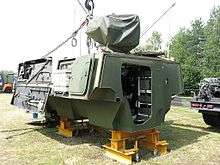
Boxer consists of two key elements: the platform/drive-line (the drive module) and the removable mission module. The A iterations applied to Boxer are specific to the drive module. Initial production examples were A0 and less than 60 were delivered. Main production was A1, followed in 2015 by A2. Current production standard depending on user is either A2 or A3. Australia is receiving an A2/A3 hybrid, in that it will receive the latest A3 drive module (rated at 38,500 kg) but with the A2 standard engine rating of 530 kW (711 hp)
The platform/drive module has the driver located front right, with the power pack to the left. The MTU/Allison powerpack can be replaced under field conditions in about 30 minutes and can, if required, be run outside of the vehicle for test purposes. Boxer is full-time all-wheel drive, the front four wheels steering. Suspension is double-wishbone coil springs, independent all round. Tyres are 415/80 R685 and a central tyre inflation system and run-flat inserts are fitted.[2]
The mission module is a key (and unique) feature of Boxer, it allows the vehicle to be rapidly changed to meet different operational requirements. Boxer mission modules are pod-like units that are fitted to drive modules to form a complete mission variant vehicle. Mission modules are attached by four points and can be swapped within an hour under field conditions. The driver can access his compartment through the mission module or in an emergency via the large single-piece power-operated hatch above this position.
Armament
Production Boxer are fitted with a variety of armament ranging from a 7.62 mm light machine gun in a remote weapon station to a 30 mm cannon in a turret. Numerous armament options are offered.

Most in-service Boxers are equipped with a remote weapon station for self-defense. Dutch vehicles are fitted with the Protector M151 RWS from Kongsberg fitted with a 12.7 mm heavy machine gun. German vehicles are usually fitted with the FLW-200 from KMW, which can be fitted with either a 7.62 mm MG3 machine gun, a 12.7 mm M3M HMG or a 40 mm GMW automatic grenade launcher. The FLW-200 has dual-axis stabilization and incorporates a laser rangefinder and a thermal imager. As possible firepower upgrade KMW has developed the FLW-200+ and presented it mounted on top of a Boxer APC at Eurosatory 2012.[39] The FLW-200+ allows the usage of a 20 mm autocannon like the Rheinmetall Rh 202 with 100 rounds loaded at the gun. The RWS is two-axis stabilized and is fitted with a CCTV camera, thermal imager and laser rangefinder.[39] It is expected that UK Boxers will be fitted with a RWS.
Lithuanian Boxers are fitted with the Israeli-made RAFAEL Advanced Defense Systems Samson Mk II RCT turret, mounting a fully stabilised Orbital ATK Mk 44 30 mm dual-feed cannon, 7.62 mm co-axial MG, and Spike-LR missiles. The turret is fitted with an independent commander's sight with both commander and gunner provided with thermal and daylight channels.
Australian Boxer CRVs mount the Rheinmetall LANCE 30 mm two-man turret, fitted with the Rheinmetall Mauser MK30-2/ABM [air-bursting munition] dual-feed stabilised cannon and 7.62 mm coaxial MG. Turret traverse is all electric through a full 360° with weapon elevation from -15° to +45° with the latter useful for urban operations. A Rheinmetall computerised fire-control system is installed, which allows stationary and moving targets to be engaged with a high first-round-hit probability while the host platform is moving. The gunner has a Rheinmetall Stabilised Electro-Optical Sighting System (SEOSS), which typically has day/thermal channels and an eye-safe laser rangefinder. The commander has a Rheinmetall SEOSS panoramic sighting system, which allows hunter/killer target engagements to take place.[2]
Protection
The Boxer is constructed from rolled all-welded steel armour to which the AMAP-B module-based appliqué armour kit can be fitted as required by mission threat estimates. AMAP-B modules are taken from the IBD Diesenroth AMAP modular armour package and are fitted to the vehicle with shock absorbing mountings.[40] Exact details of Boxer protection levels have now been classified. According to ARTEC, the vehicle will withstand anti-personnel and large anti-tank mines of an undisclosed type under the wheel, platform or side attack. It has previously been stated that Boxer's baseline armour is all-round resistant to 14.5 mm armour-piercing ammunition in accordance with STANAG 4569 Level 4.
To increase survivability in case of armour penetration, the crew compartment is completely covered by an AMAP-L spall liner. The spall liner stops most of the fragments of the armour and projectile brought about by hull penetration. To further enhance crew protection, the seats are decoupled from the floor, this preventing the shock of a mine-detonation being directly transmitted to the crew. The roof armour of the Boxer is designed to withstand artillery fragments and top attack weapons such as bomblets fitted with a High-Explosive Anti-Tank (HEAT) warhead.
The Boxer drive module A1 (as designated by the German BWB) is an upgraded version of the baseline A0 version of the Boxer drive module, with the primary difference being the installation of a mine protection package fitted to the belly and wheel stations of the vehicle. The vehicle is fitted an additional armour package focused on protecting against side and underbody blast threats. This consists of the AMAP-M and AMAP-IED packages. An unspecified electronic countermeasure (ECM) system was also fitted to counter IEDs. These changes result in a 1,058 kg weight increase for the A1 over the baseline A0 APC variant. For the A2 Boxer protection is reported to have been increased further.[16]
Mobility
_Boxer_-_Motor.jpg)
The powerpack of Boxer consists of a MTU 8V199 TE20 diesel developing (originally) 720 hp and coupled to an Allison HD4070 fully automatic transmission with seven forward and three reverse gears. The powerpack can be replaced under field conditions in approximately 20 minutes. The MTU 8V199 TE20 engine is a militarised further development of the Mercedes-Benz OM 500 truck engine, modified by MTU to produce increased power via changes to the turbocharger, fuel injection and cooling systems. To maintain mobility levels at increased operating weights, the 8V199 TE20 is now available developing either 530 kW (711 hp) or 600 kW (805 hp), and when the drive module is fitted with the 600 kW version of this engine it is designated A3. Boxer is fitted with three fuel tanks containing a total of 562 litres, divided between a 280-litre front tank, 238-litre rear tank, and a 44-litre reserve tank.[16]
Boxer has full-time 8 × 8 drive with differential locks on all axles and the front four wheels steer. Tyres are 415/80 R27 Michelin XML on German and Dutch Boxers, with the Land 400 prototypes being fitted with 415/80 R 685 Michelin XForce 2, these having a 500 kg per wheel greater load rating than the XML and being more 'all-terrain' in design than the rocks/mud-optimised XML.[41] Standard fit for Australian and UK Boxers will be 415/80 R 685 Michelin XForce ZL rated to carry 5,600 kg each.[16]
A central tyre inflation system (CTIS) is fitted, and run-flat inserts allow for 30 km travel at up to 50 km/h in the event of a flat. Braking is provided by Knott pneumatic ABS on all wheels with main braking power actuated on the front two axles. Suspension is of the fully independent double wishbone type with coil springs.[42][16] Boxer can be transported in the Airbus A400M tactical airlifter.
Boxer variants and mission modules overview
In no particular order of significance
- Armoured Personnel Carrier — The armoured personnel carrier (APC) variant can be considered a baseline configuration for Boxer. The German Army received 125 APC modules as part of the initial 272-vehicle order. All 131 vehicles from the second German Army order will be in a new configuration of the armoured personnel carrier (Gepanzertes Transportfahrzeug) and in A2 configuration.[43]
- Command Post — The command post variants of Boxer are used for command and control in theatre, acting as a centre for tactical communications. Secured communication, displays for situational awareness and instruments for network-enabled warfare are key characteristics of this variant.[44] In standard configuration the command post module offers room for four workstations and the vehicle crew consists of driver, commander/weapon operator, two staff officers, one staff assistant and one additional crew member.[42] The German Army received 65 command post modules as part of the initial 272-vehicle order; the Dutch Army ordered 60 command post modules originally, but later reduced this to 36 modules. Australia and the UK will also receive command post variants of Boxer. Lithuania's command post variants will be based around the IFV.[45] The UK has a requirement for a command and control mission module this designated Mechanised Infantry Vehicle Command and Control (MIV-CC), and Australia has a requirement for a command and control mission module, plus a specialist surveillance mission module.
- Ambulance — The German Army received 72 ambulance modules as part of the initial 272-vehicle order; the Dutch Army ordered 52 ambulance modules. The German and Dutch Boxer ambulance variant utilises a mission module with a raised roofline providing an internal height of 1.85 m and volume of 17.5 m3 to accommodate the increased equipment used in an ambulance vehicle. In Dutch service the Boxer ambulance replaced the YPR-765 prgwt variant of the AIFV (Armored Infantry Fighting Vehicle) casualty transport and it can accommodate seven casualties that are seated or three lying down on stretchers, or one of the following combinations: three seated and two lying down, or four seated and a single casualty lying down. The crew consists of driver, commander and a single medic. The Dutch vehicle, a medical evacuation vehicle, differs from the German medical treatment vehicle. Australia and the UK have ordered ambulance modules, the UK variant to be known as Mechanised Infantry Vehicle Ambulance (MIV-A).[46]
- Combat Reconnaissance Vehicle — The combat reconnaissance (CRV) is a development of the baseline Boxer designed to fulfil the Australian LAND 400 Phase 2 requirement. It mounts the Rheinmetall Defence Lance modular turret system (MTS) fitted with the MK30-2/ABM cannon.[16] Other variants being developed for Australia are an Ambulance, a Command & Control, a Joint Fires, a Surveillance, and Repair & Recovery variants.[47]
- Vilkas (Wolf) — 89 of 91 Lithuanian Vilkas/Wolf will be fitted with the Rafael Advanced Defense Systems Samson Mk II RCT turret mounting a fully stabilised Orbital ATK Mk 44 30 mm dual-feed cannon, 7.62 mm co-axial MG, and Spike-LR missiles. A range of turret options were bid including the unmanned LANCE turret from the PSM Puma IFV, however the selected vehicle mounts the Rafael Advanced Defense Systems Samson Mk II RCT armed with a 30 mm cannon, 7.62 mm co-axial MG, and Spike-LR missiles. Lithuania will receive four variants of the IFV, 55 IFV squad leader, 18 IFV platoon leader; 12 IFV company leader; 4 IFV command post. Variants vary by mission fit primarily in the areas of additional voice and data communication equipment as well as modified BMS. Two driver training vehicles are also included in the Lithuanian order.[16][48]
- Geniegroep – The Boxer Geniegroep (GNPR) is a Dutch-specific engineering and logistics support vehicle that is deployed for the transport of troops and engineer group equipment. It provides seating for six dismounts with space available for their personal equipment and an additional separate stowage section for munitions. It may be deployed as a support vehicle with other units or used for independent assignments such as route clearance, or as a protected work location during mine clearance or demolition operations.[49] The Boxer GNGP replaces the YPR-765 prgm/PRCO-C3 variant of the AIFV (Armored Infantry Fighting Vehicle). The Royal Netherlands Army initially ordered 53 GNPR, this later revised to 92, and has subsequently converted 12 of the 92 GNGP vehicles ordered to Boxer Battle Damage Repair (BDR) configuration.[50] The BDR variant is able to accommodate the special equipment, tools, expendable and non-expendable supplies needed to carry out diagnoses, maintenance and minor repairs if required.[51] Crew consists of an engineer commander, driver, observing commander, gunner, and five engineers.
- Cargo — The Boxer Cargo is a Dutch-specific variant that replaces the YPR-765 prv variant of the AIFV (Armored Infantry Fighting Vehicle). It is equipped with a special loading floor to secure cargo during transport and can transport a maximum of two standard one tonne army pallets (max. load 2,5 t[52]). The interior design of the vehicle allows adaptation as necessary for different kinds of missions. For conducting peace-keeping missions or other peacetime operations the set of vehicle equipment can be changed and tailored to suit as required.[53] Crew consists of commander/gunner and driver. 27 cargo examples were originally ordered, this later revised to 12.[54] A cargo variant was the final Dutch Boxer produced.
- Driver Training Vehicle — This driver training vehicle (DTV) variant is equipped with a training module. The driver sits in the conventional driver's station and the instructor is seated in an elevated position in the driver training cabin. Active occupant protection is designed to protect the crew sitting exposed in the driver training cabin. In the event of a roll-over accident, the instructor and upper occupant seats are electronically retracted into the Driver Training Module. In normal use, the instructor can monitor the trainee driver via a duplicated control and display unit and override gear selector, brake and accelerator pedal of the driver's station. Steering override is available as an option.[55] Crew consists of a trainee driver, instructor, plus up to two additional trainee passengers. The Australian, Dutch (8), German (10) and Lithuanian (2) armies operate driver training vehicles.[56]
- Repair and Recovery - Australia and the UK will receive a repair and recovery mission module, the details of which have yet to be released. The UK designation for this variant is Mechanised Infantry Vehicle Repair and Recovery (MIV-REC).
- Other identified modules — Of the four Boxer build configurations currently proposed for the UK's Mechanised Infantry Vehicle (MIV) requirement there is also the generic Mechanised Infantry Vehicle Protected Mobility (MIV-PM), this believed to be a reconfigurable personnel carrier. Of the seven Boxer variants required by Australia there is also a joint fires mission module and a surveillance mission module.
During an interview with Jane's at IAV 2020, Stefan Lishka, MD of ARTEC commented that the term "configuration" had superseded variant for Boxers, and Boxer modules. The reason for this was that some current/planned variants (build configurations) are interchangeable by crew members.
Other variants including prototypes, concepts and developmental platforms
- Boxer JODDA — Boxer JODAA (joint operational demonstrator for advanced applications) is a technology demonstrator used by the German Army and Rheinmetall Landsysteme to carry out R&D studies around potential Boxer improvements. It is based on the Boxer armoured medical treatment vehicle variant and is regularly refitted for a range of purposes and roles.[16]
- Boxer fitted with Oerlikon Skyranger - Boxer has also been shown fitted with the Oerlikon Skyranger air defence system turret. This is armed with Rheinmetall's 35mm x 228 calibre Revolver Gun, this having the option of a dual ammunition feeding system that allows the operator a choice of two types of shell. It would primarily fire the 35 mm Advanced Hit Efficiency And Destruction (AHEAD) ammunition, which although optimised for the air defence role is highly effective against ground targets including lightly protected vehicles. The secondary nature would be Frangible Armour-Piercing Discarding Sabot (FAPDS) ammunition. The gun has a cyclic rate of fire of 1,000 rounds a minute, with a typical aerial target being engaged by a burst of 20 to 24 rounds.
- Boxer IFV Demonstrator/RCT30 — Boxer IFV Demonstrator is a technology demonstrator used by Rheinmetall Landsysteme to demonstrate, market, and test the company's preferred configuration for an IFV variant of the Boxer platform. Boxer RCT30 IFV is a technology demonstrator used by KMW for the same purposes. The vehicle mounts the unmanned Rheinmetall RCT, the latest development of the turret fitted to the German Army's PSM Puma IFV. The turret is installed on the forward part of the rear Boxer mission module and armed with the stabilised Orbital ATK Armament Systems 30 mm MK44 dual-feed cannon with option of a coaxial 7.62 mm MG. On top of this is the KMW FL 200 RCWS armed with a 12.7 mm MG that can be replaced by a 5.56 mm or 7.62 mm MG or a 40 mm AGL. It was stated that an alternate primary armament, the Mauser MK30-2 ABM dual-feed 30 mm cannon could be installed if requested.
- Boxer Armoured Recovery Module (ARM) — The Boxer ARM is a repair and recovery mission module developed by FFG to provide Boxer users with an intimate recovery and maintenance capability as well as an operational means to mount mission modules onto drive modules.
- Boxer RCH155 — Boxer RCH155 mounts a version of the KMW Artillery Gun Module (AGM). This is a further development of the PzH 2000 155 mm 52-calibre artillery system. The system was developed to meet potential requirements of export customers as the wheeled platform has greater strategic mobility than tracked and heavier PzH 2000-type systems. It has been confirmed that initial firing trials have taken place.
- Boxer WFEL bridging module concept — The Boxer WFEL bridging module concept is a variant designed by WFEL and KMW as a private venture, to meet the need to integrate the Leguan bridging system onto medium-sized vehicles. The concept model is expected to fit onto the standard Boxer without the need to design a new platform. The concept model is expected to launch a 14 m span bridge with the potential of a 22 m span bridge which is yet to be designed.
Gallery
- ARTEC Boxer
.jpg) Boxer prototype 2. The Boxer was designed by an international consortium to accomplish a number of operations through the use of installable mission modules.
Boxer prototype 2. The Boxer was designed by an international consortium to accomplish a number of operations through the use of installable mission modules.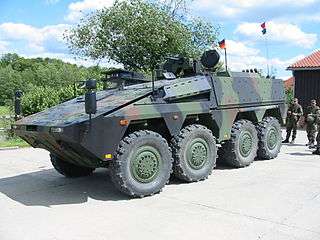 A prototype Boxer seen in 2004. Production deliveries were scheduled to commence in 2004, but numerous design changes combined with political problems delayed production until 2008
A prototype Boxer seen in 2004. Production deliveries were scheduled to commence in 2004, but numerous design changes combined with political problems delayed production until 2008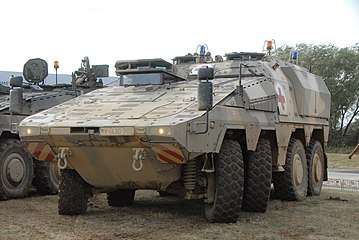 German Army Boxer in ambulance configuration. The German and Dutch base vehicles are virtually identical, mission modules and fitments the only significant difference.
German Army Boxer in ambulance configuration. The German and Dutch base vehicles are virtually identical, mission modules and fitments the only significant difference.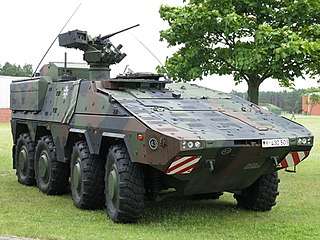 German Boxer with FLW-200 remote weapon station
German Boxer with FLW-200 remote weapon station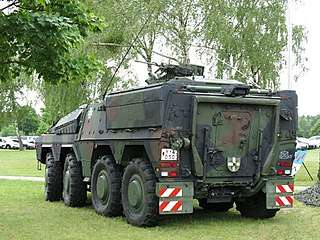 From the rear, a German Army Boxer fitted with a FLW 200 RWS
From the rear, a German Army Boxer fitted with a FLW 200 RWS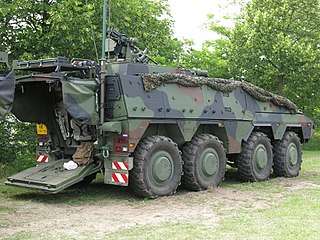 Dutch Army Boxer in command post configuration - 36 of which were ordered
Dutch Army Boxer in command post configuration - 36 of which were ordered- Driver training variant of Boxer; this variant has been ordered by Australia, Germany, Lithuania and the Netherlands
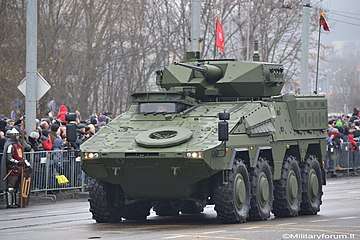 Lithuanian Army Vilkas (Boxer) IFV.
Lithuanian Army Vilkas (Boxer) IFV.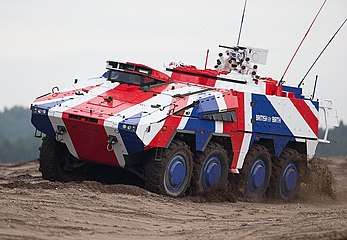 Boxer is currently being offered to meet the UK's Mechanised Infantry Vehicle (MIV) requirement.
Boxer is currently being offered to meet the UK's Mechanised Infantry Vehicle (MIV) requirement._-_10.jpg) Four Boxer variants are currently proposed for the UK's Mechanised Infantry Vehicle (MIV) requirement, these being Mechanised Infantry Vehicle Protected Mobility (MIV-PM), Mechanised Infantry Vehicle Command and Control (MIV-CC), Mechanised Infantry Vehicle Ambulance (MIV-A), and Boxer Mechanised Infantry Vehicle Repair and Recovery (MIV-REC).
Four Boxer variants are currently proposed for the UK's Mechanised Infantry Vehicle (MIV) requirement, these being Mechanised Infantry Vehicle Protected Mobility (MIV-PM), Mechanised Infantry Vehicle Command and Control (MIV-CC), Mechanised Infantry Vehicle Ambulance (MIV-A), and Boxer Mechanised Infantry Vehicle Repair and Recovery (MIV-REC).
Operators
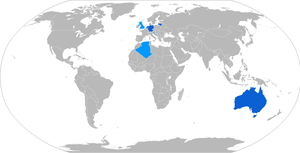
Current operators



.svg.png)
Future operators


Possible future operators

References
- "Progress and prospects for the protected transport vehicle GTK Boxer". Europäische Sicherheit & Technik. 7 February 2020. Retrieved 28 April 2020.
- "GTK/MRAV/PWV (Boxer) Wheeled Armoured Vehicle Programme". IHS Jane's Christopher F Foss. 2016-10-21. Retrieved 2017-03-23.
- "MTU Shop". Mtu-online-shop.de. Retrieved 20 November 2014.
- "Rheinmetall MAN Military Vehicles GmbH". Rheinmetall Defence. Retrieved 2015-09-10.
- "Rheinmetall MAN Military Vehicles Nederland B.V." Rheinmetall Defence. Retrieved 2015-09-10.
- "Boxer MRAV Multi Role 8x8 Armoured Vehicle data pictures video".
- "German Parliament Approves Boxer Acquisition". Defense-update.com. Archived from the original on 2007-02-13. Retrieved 2006-12-13.
- "Germany orders 131 more Boxers". Jane's Defence Weekly. Retrieved 2017-03-24.
- "IAV 2020: BOXER - Interview with Stefan Lishka, MD of ARTEC". Janes. Retrieved 2020-02-05.
- "Lithuania has received two training Boxer APC". www.weaponnews.com. Lithuanian MoD. Retrieved 2017-06-19.
- "Boxer Lithuania". Janes. Retrieved 2020-02-05.
- "Boxer Jane's AFVs". Janes. Retrieved 2020-02-05.
- "Bundeswehr Boxer upgrade gets green light". Jane's Defence Weekly. Retrieved 2017-06-28.
- "Rheinmetall to modernize the Bundeswehr's Boxer command vehicles". Rheinmetall Group. Retrieved 2017-07-04.
- "Slovenia". Jane's. Retrieved 2019-07-26.
- "GTK/MRAV/PWV (Boxer) Wheeled Armoured Vehicle Programme (Sept 2019 updates". IHS Jane's. 2019-09-20. Retrieved 2019-09-25.
- Kerr, Julian (28 July 2016). "Australia shortlists AMV35, Boxer for future combat reconnaissance vehicle". Jane's IHS. Retrieved 29 July 2016.
- http://www.defence.gov.au/casg/multimedia/land_400_phase_2_flyer_-_web-9-7895.pdf
- McMahon, Amelia (2018-03-12). "LAND 400 Phase 2 decision revealed". Retrieved 2018-03-14.
- "Queensland trounces Victoria in bid for $5 billion Army deal". ABC News. 2018-03-14. Retrieved 2018-03-14.
- https://assets.documentcloud.org/documents/4408211/Australian-supply-chain-and-Defence-facilities.pdf
- "Defence Connect". defence connect. 13 March 2018. Retrieved 13 March 2018.
- Grevatt, Jon (14 March 2018). "Rheinmetall's Boxer selected for Australia's Land 400 requirement". Jane's IHS. Retrieved 31 March 2018.
- Bebb, Guto (31 March 2018). "British Ministry of Defence announces they will re-join the Boxer programme". GOV.UK. Retrieved 31 March 2018.
- "British Army re-joins Boxer programme". Rheinmetall-defence.com. 3 April 2018. Retrieved 3 April 2018.
- Chuter, Andrew (26 October 2016). "Britain's Soft Spot for Germany's Boxer Vehicle Raises Eyebrows in Industry". Defense News. Retrieved 27 October 2016.
- Foss, Chris (29 November 2017). "German Boxers deploy to UK". Jane's JDW. Retrieved 7 December 2017.
- Tovey, Alan (4 February 2018). "UK jobs pledge in battle to win £2bn contract for new Army vehicle deal". The Telegraph. London, UK. Retrieved 5 February 2018.
- "Last Dutch Boxer rolls off production line". janes.com. 24 July 2018. Retrieved 31 July 2018.
- "Lithuanian Boxers enter trials". janes.com. 23 July 2018. Retrieved 31 July 2018.
- "UK orders 400-600". ted.europe.eu. 19 July 2018. Retrieved 23 July 2018.
- "British Companies Get Green Light to Press Ahead with New Army Vehicle Plans, Defence Minister Announces". defense-aerospace.com. 19 September 2018. Retrieved 21 September 2018.
- "Australian Government inspects first Australian Boxer vehicle at Rheinmetall in Kassel, Germany". rheinmetall-defence.com. 29 March 2019. Retrieved 29 March 2019.
- https://defense-update.com/20190121_iron-fists-aps-for-the-australian-boxers.html
- https://adbr.com.au/boxer-crv-to-get-an-iron-fist/
- Felstead, Peter (2016-06-15). "Eurosatory 2016: ST Kinetics launches Terrex 3 IFV". IHS Jane's. Archived from the original on 2016-11-12. Retrieved 2016-11-11.
- Foss, Christopher F (2016-01-01). "Patria awaits first contract for latest AMV XP". IHS Jane's. Archived from the original on 2016-03-20. Retrieved 2016-11-11.
- "VBCI: France's Wheeled APC". Defense Industry Daily. 2014-10-13. Retrieved 2016-11-11.
- Elbertzhagen, Timo. "GTK Boxer im Einsatz in Afghanistan – erste Erfahrungen" (PDF). Wehrtechnik (IV/2012). Mönch Publishing Group. Archived from the original (PDF) on 10 March 2014. Retrieved 23 September 2015.
- Nitschke, Stefan. "Schutz bei Rad- und Kettenfahrzeugen – Teil 1" (PDF). Wehrtechnik (Wehrtechnik I 2011 page 52-57). Mönch Publishing Group. Archived from the original (PDF) on 13 September 2011. Retrieved 23 September 2015.
- "GTK/MRAV/PWV (Boxer) Wheeled Armoured Vehicle Programme Jan 2018". IHS Jane's Christopher F Foss. 2018-01-09. Retrieved 2018-01-26.
- "GTK/MRAV/PWV (Boxer) Wheeled Armoured Vehicle Programme May 2017". IHS Jane's Christopher F Foss. 2017-05-03. Retrieved 2017-05-03.
- "Boxer Jane's Armoured Fighting Vehicles January 2020 updates". Jane's. 23 January 2020. Retrieved 11 February 2020.
- "artec-boxer.com: Command Post Vehicles". Artec-boxer.com. Retrieved 20 November 2014.
- "Boxer Jane's Armoured Fighting Vehicles January 2020 updates". Jane's. 23 January 2020. Retrieved 11 February 2020.
- "Boxer Jane's Armoured Fighting Vehicles January 2020 updates". Jane's. 23 January 2020. Retrieved 11 February 2020.
- "Boxer Jane's Armoured Fighting Vehicles January 2020 updates". Jane's. 23 January 2020. Retrieved 11 February 2020.
- "Boxer Jane's Armoured Fighting Vehicles January 2020 updates". Jane's. 23 January 2020. Retrieved 11 February 2020.
- "artec-boxer.com: Armoured Engineer Group Vehicle". Artec-boxer.com. Retrieved 20 November 2014.
- "Boxer Jane's Armoured Fighting Vehicles January 2020 updates". Jane's. 23 January 2020. Retrieved 11 February 2020.
- "artec-boxer.com: Battle Damage Repair Vehicle". Artec-boxer.com. Retrieved 20 November 2014.
- Gerhard Heiming: Erster Boxer in Transportversion, Europäische Sicherheit & Technik, Ausgabe 5/2016, S. 7.
- "artec-boxer.com: Cargo Vehicle". Artec-boxer.com. Retrieved 20 November 2014.
- "Boxer Jane's Armoured Fighting Vehicles January 2020 updates". Jane's. 23 January 2020. Retrieved 11 February 2020.
- "artec-boxer.com: Driver Training Vehicle". Artec-boxer.com. Retrieved 20 November 2014.
- "Boxer Jane's Armoured Fighting Vehicles January 2020 updates". Jane's. 23 January 2020. Retrieved 11 February 2020.
- "Lithuania to proceed with Germany's Boxer in armoured vehicle purchase". Reuters. December 11, 2015. Retrieved December 11, 2015.
- "Lithuania joins Boxer programme". www.yourindustrynews.com. OCCAR. Archived from the original on 23 August 2016. Retrieved 22 August 2016.
- "Minister J. Olekas: "The Contract of 88 IFV is the signal that Lithuania takes care of its security and investments into it seriously". Ministry of National Defence of the Republic of Lithuania. August 22, 2016. Retrieved August 22, 2016.
- scheme=AGLSTERMS. AglsAgent; corporateName=Commonwealth of Australia, Department of Defence; address=Russell Offices. "Land Combat Vehicle System : Equipping Defence : Department of Defence". www.defence.gov.au. Retrieved 2020-02-29.
- "Joint media release - Prime Minister, Minister for Defence Industry and Minister for Defence - New Vehicles to protect our troops and create 1450 jobs". 14 March 2018. Retrieved 15 March 2018.
- Dominguez, Gabriel (2018-08-17). "Australia orders 211 Boxer wheeled armoured vehicles". Janes. Archived from the original on 2018-08-17. Retrieved 2018-08-18.
- "UK orderSustainment". ted.europe.eu. 19 July 2018. Retrieved 23 July 2018.
- "British companies get green light to press ahead with new Army vehicle plans, Defence Minister announces". Gov.uk. 19 September 2018. Archived from the original on 2018-09-19. Retrieved 23 September 2018.
- Cranny-Evans, Samuel (21 September 2018). "DVD 2018: UK proceeds with Boxer procurement". IHS Jane's 360. London. Archived from the original on 2018-09-21. Retrieved 23 September 2018.
- "Rheinmetall, BAE Systems launch joint venture for military vehicles". Defense News. Retrieved 25 January 2019.
- "Rheinmetall, BAE Systems to form UK-based JV". Shephard Media. Retrieved 25 January 2019.
- "BAE Systems sells control of vehicles arm to Rheinmetall". BBC. Retrieved 25 January 2019.
- "BOXER for the British Army". army.mod.uk. 5 November 2019.
- "UK Joins the BOXER Family". occar.int. 5 November 2019.
- http://www.defense-aerospace.com/articles-view/release/3/202330/algeria-to-produce-boxer-infantry-combat-vehicle.html
- https://www.defenceweb.co.za/featured/algeria-will-reportedly-produce-boxer-vehicles-under-license/
- Bingham, James (8 February 2018). "Slovenia selects Boxer". IHS Jane's 360. London. Archived from the original on 8 February 2018. Retrieved 8 February 2018.
- Turnbull, Grant (5 February 2018). "Slovenia selects Boxer to meet 8x8 requirement". Shephard Media. London. Retrieved 7 February 2018.
- "The BOXER family grows and grows... SLOVENIA to join the BOXER Programme". OCCAR. 12 April 2018. Retrieved 12 April 2018.
- "Slovenia Will Not Buy €306m Boxer Armoured Vehicles Until Tactical Study Undertaken". www.total-slovenia-news.com. 22 February 2019.
External links
| Wikimedia Commons has media related to GTK Boxer. |